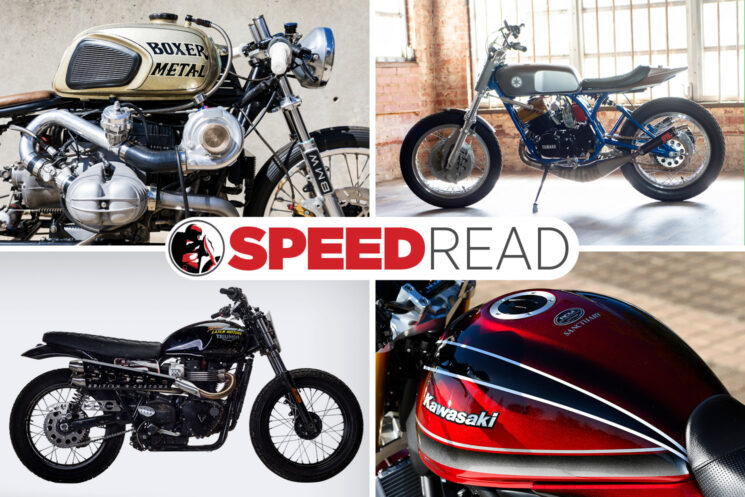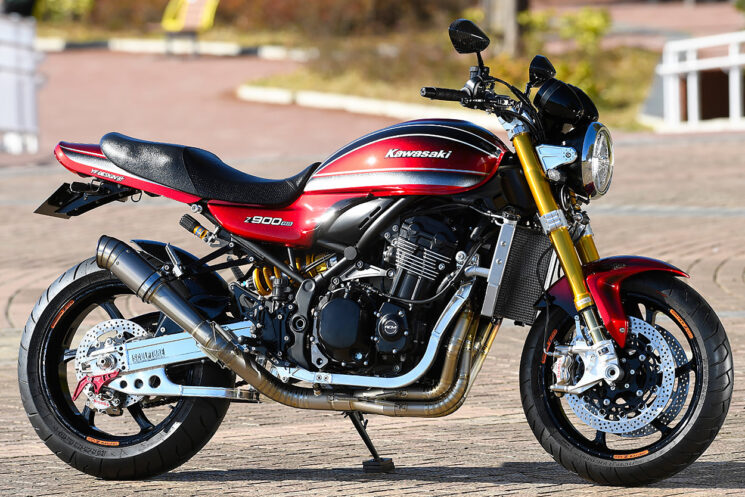Speed Read, March 26, 2023
We’ve got two very different Triumph Thruxton customs on the menu this week. One is a liquid-cooled supercharged brute, and the other a fully-faired air-cooled
café racer. A tidy Yamaha Scorpio scrambler, and a skinny Harley FXD, fill the spaces in-between.
Supercharged Triumph Thruxton 1200R by Tamarit Motorcycles We’ve never thought of the
Triumph Thruxton 1200R as underpowered. In fact, it’s one of the more powerful modern café racers you can walk into a showroom and buy today. But when
Tamarit Motorcycles set out to create their 95th custom Triumph, they wanted something a little…more. And by ‘a little’ we actually mean ‘a lot.’
This is their latest custom Thruxton 1200R, and to be honest, from the left-hand side it looks like one of their more understated builds. It would be, if it weren’t for the huge TTS Performance supercharger bolted to the right-hand side of the engine. It’s added 60 buff horses to the Thruxton—so this 1200 now produces 160 hp. Giddy up.
Tubeless (and very flashy) Kineo spoked wheels were fitted, as was a whole suite of Motogadget electronics. The headlight is especially trick—it has a gyroscopic sensor inside and lights up the edge of the road as you lean.
The Thruxton’s clip-ons were swapped out in favor of a flat handlebar, and the factory tank was painted in a beautiful silver color. The tank proudly wears the Tamarit badge, and the engine side covers have been replaced with custom ‘San Jorge 95’ badges, which is the name of the bike.
The Zard exhaust is new, as is the whole centre section of the motorcycle. A custom airbox sits beneath the custom seat, which is stitched by hand in tan leather. We love the way the seat extends onto the tank and how the leather tank strap matches the seat. Very classy, indeed.
The bike has already been shipped off to its new owner in Texas, USA. This kind of thing lights our fire—so if someone would be as kind as to get in touch with Tamarit to build another, we’d appreciate it greatly. [
More]
Yamaha Scorpio by Deus Bali We couldn’t quite figure out what this custom
scrambler started life as when we first saw it. Believe it or not, this was a Yamaha Scorpio—a 225 cc commuter bike, popular in Australasia.
Owned by the manager of Deus ex Machina’s Bali outpost, this tower of power has been ridden every day for the last 10 years. The Deus team thought it was time to refresh the daily rider, so they promptly ripped into it—again. For the fifth time.
Deus Bali set out to breathe new life into the tired Scorpio, so they started by completely rebuilding the engine. No horses were left behind, especially thanks to the larger 30 mm Uma Racing PWK carb and appropriately oversized K&N air filter.
A new exhaust header was built from stainless steel, further increasing the already sky-high power figures. That supercharged Thruxton has nothin’ on this.
41 mm forks from another Yamaha bike were grafted on, as were the top and bottom fork yolks. A set of ProTaper handlebars were bolted on and finished with new grips and switches. An oversized LED headlight takes care of lighting duties, with a set of barely perceptible, but overly bright Kellerman Atto Dark turn signals fitted.
The bolt-on subframe is all-new too, and it really shows off the rear end. The alloy swingarm was donated by a Yamaha YZ250, and a box was built under the seat to house the battery and electronics. The tail light is especially nice and was custom-made by the Bengkel Boys themselves in the Deus Bali workshop.
Rossi rims and stainless spokes were laced to the factory hubs and then shod with Shinko SR428 dual-sport rubber. A pair of hand-made aluminum fenders round out the build.
Painted in metallic red paint, the custom tank was finished off with the Deus ‘Pistons-O-Power’ logo—a worthy stamp of approval from the Deus Bali head honcho himself. We love it. [
More]
Triumph Thruxton by iT ROCKS!BIKES It’s big, it’s blue, and, despite its name, it’s still rocking a good old fashioned internal combustion engine. Dubbed ‘Lithium’ by its creators, this café racer is the latest build from Portugal’s iT ROCKS!BIKES.
The iT ROCKS!BIKES proprietors—Osvaldo, Ana and Luis—were approached by a customer with a request to build them a 70s-inspired Triumph endurance racer. Knowing a thing or two about building svelte, monocoque-bodied motorcycles, this wasn’t going to be a problem for the IRB team.
To make it even easier, the client specified only the classic Porsche blue color—leaving the rest of the decisions in the hands of the makers.
An air-cooled 2006-model Triumph Thruxton was put under the knife, and transformed into the fully-faired café racer you see here. Using designs that Ana penned, the team cut the back end down, then fabricated a custom mounting frame for the front.
This is what carries the beautiful classic full fairing, which was also made by hand, from steel. The stacked headlight is the only modern touch on the fairing, but we absolutely adore it. The one-piece tank and seat unit was also crafted by hand, as were the side covers.
Kineo wheels make another appearance in this week’s Speed Read, with ITB fitting a set to this Thruxton. The forks are from a Yamaha R1, and the rear shocks were swapped out for a pair of fully adjustable Bitubo units. The parts spec includes LSL clip-ons and rear-sets, and a Motogadget Chronoclassic speedometer.
Finished in classic Porsche blue, white and silver paint, with black leather on the seat, the iT ROCKS!BIKES trio has nailed the brief on yet another outstanding build. We bet the client is one happy chap. [
Via]
Harley Davidson FXD by K-Speed It seems that every bike that rolls into, and then out of, the
K-Speed workshop is a perfect 10. Based in Bangkok, Thailand, K-Speed has been banging out bangers since 2002—and they’re not showing any signs of slowing down.
This custom 2002-model Harley Davidson FXD Dyna Super Glide is the personal ride of K-Speed boss Eak. Nicknamed ‘Silver Sting’ (possibly because it’s long, narrow and pointy), Eak set out to create a vintage-inspired custom of yore. Suffice it to say, he and his crew have done a fantastic job.
The highlight of the build is the custom bodywork. Made from aluminum, the new tank and fender do a great job of slimming down the chunky American chop. K-Speed wanted to make the big Harley look skinnier and easier to use, and the bodywork was just the beginning.
The front end has been put on a diet too, and now rocks a classic front tire in front of a single bottom-mount headlight.
The swooping handlebars are new, as are the grips and controls. The front indicators are mounted low on the frame down tubes, right next to a Moon Equipment fuel container for emergency fuel top-ups (because whoa, that’s a small tank).
Moving rearwards, a new seat from K-Speed’s Diablo range of parts was fitted, along with new indicators and rear shocks. A side-mount numberplate and tail light bracket were added too, to keep the new rear fender clear of clutter.
The engine remained stock but was treated to a new set of exhaust headers. What they lack in length, they undoubtedly make up for in volume. Just Harley things, you know?
It’s gloriously simple, but cool as heck. It’s good to be the boss, hey Eak? [
K-Speed | Images by
Hipmotography]
Continue reading...



























































 ; all spring and no damper.”
; all spring and no damper.”




































































